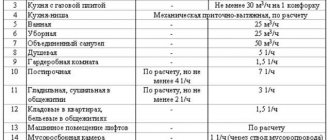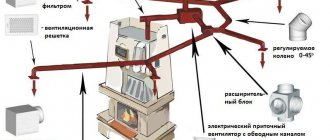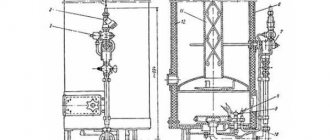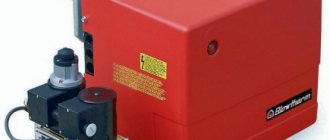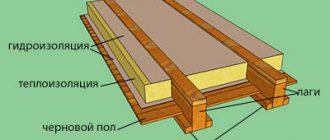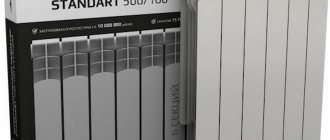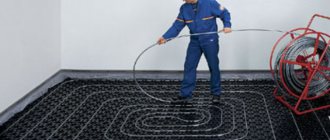Rating: 3,433
Despite the fact that the heating system of premises is already quite developed, there are still points that were previously missed, and therefore modern heating technologies are appearing, one of which is gas heat generators for air heating of the house.
So, for example, for semi-industrial premises, where previously separate small rooms for the furnace were used, mechanisms that are not expensive to use, install and purchase have appeared - gas heat generators for air heating of the house. And what is perhaps the most important thing about them is that you do not need to hire an additional person to monitor the heating level.
Heat generator in heating
Maintaining a certain temperature regime in industrial premises, especially in winter, is quite difficult if a heating system .
Heating a large area or installing stationary heating that receives heat from a mini-boiler room is too expensive and cumbersome. Therefore, many people, including owners of country houses with large square footage, resort to the help of heat generators.
A heat generator is a device that has a complex internal structure and produces heat, which, with the help of a fan, is distributed with air flow throughout the entire area . This unit is quite powerful, capable of heating an area to a comfortable temperature of 60-70 sq.m. in just 10-15 minutes. The only difficulty that accompanies all owners of heat generators is the cost of both the unit itself and the consumed fuel on which it operates. Otherwise, the device shows only its positive sides, allowing you to heat quickly, a lot and with high quality.
The video is about a solid fuel stove heat generator
Structure and design features
The heat generator consists of such structural parts as:
- Combustion chamber – this is where the process of fuel combustion and heating of the coolant takes place.
- Burner - supplies compressed oxygen to the combustion chamber to support the combustion process.
- Fan – ensures the distribution of heated air in a spatial room.
- Heat exchanger is a chamber from which heated air comes out.
- Filters and hoods prevent flammable gases from entering the air of a heated area.
The type and design of the burner directly depends on what kind of fuel is used (liquid, solid or gaseous). If desired, the burner can be replaced with your own hands, and the entire system is adjusted to the type of fuel that the customer desires.
The main advantage and feature of the design is the fact that the chambers and compartments of the heat generator are located in such a way that the spent fuel (more precisely, its decay products) does not mix with the air that circulates in the room.
This is very important because spent fuel is a toxic gas that can cause asphyxiation to people living in heated areas. A high level of safety, as well as environmental friendliness, allows the use of heat generators not only in industry, but also in everyday life.
Another advantage is the absence of an intermediate coolant that would require additional heating (pipes, batteries, coils, etc.). That is, the heat generated from fuel combustion is completely spent on heating the air, and is not spent on heating the coolant. This allows you to increase efficiency up to 95%, and the result is felt immediately after the heat generator starts working.
One example of an air heat generator, manufacturer Robust
Operating principle of the heating system
Fuel is supplied to the combustion chamber, where the heat exchanger heats up during the combustion process.
The fan uses its blades to capture air in the room and passes it through the heat exchanger. Heated air circulates throughout the room, performing several cycles. The operating principle is quite simple and has many advantages. You should not be afraid that during operation the pipe will burst and the neighbors below will end up in the water, and you will be in an unpleasant situation, which, moreover, will hit your pocket. The device is completely safe and also has automatic sensors that stop fuel combustion when there are threats of breakdown or emergency situations.
Air heated in the heat generator can be supplied to the room in two ways :
- Directly from the fan - heated air circulates and also replaces cold air, regulating and maintaining the temperature. This type of heating system is only convenient if the heated areas are not large.
- Through a system of interconnected air ducts, heated air (using artificial ventilation) circulates through the air ducts, heating several rooms at once from one generator. It is used for heating large pavilions and utility rooms with many separate rooms.
The generator itself can be installed both directly indoors and outside, on the street. The type of heat generator, which has an additional protection system from the influence of weather conditions (high humidity, frosty weather, snow cover), will depend on this indicator.
The key condition for the full functioning of a heating system using a heat generator is the correct connection of the exhaust pipe to the chimney, as well as the presence of draft from the latter. If the chimney is clogged, it is important to clear it of accumulated soot before installing the system. Otherwise, toxic substances may enter the heated room, causing poisoning.
The video shows the operation of the Totem solid fuel heat generator
Types of heat generators
A person’s heating needs determine the type of generator, of which there are a huge number today.
They are differentiated not only by the fuel used, but also by other parameters:
- By dimensions and weight:
- mobile – easy to transport;
- stationary - used only in a certain place, there are two types: hanging - can be used both indoors and outdoors;
- floor - used only indoors.
- According to the method of fuel combustion and distribution of heated air:
- horizontal – air exchange occurs in a horizontal projection, convenient when a small room is heated;
- vertical - heated air circulates from bottom to top, providing heating for rooms with high ceilings.
- By type of fuel burned:
- gas - the most common and cheapest type of fuel, allowing significant savings on heating (high heat transfer during combustion);
- diesel - they run on diesel fuel, but require annual cleaning and maintenance, as combustion products pollute the unit;
- vortex - the operating principle is based on complex physical processes that make it possible to obtain energy from water;
- universal - can work on both liquid and solid fuels, as well as on wood, vegetable oil, manure, peat and coal.
The choice of fuel directly depends on factors such as:
- intensity and speed of air heating;
- the amount of fuel consumed and heating costs in monetary terms;
- the cost of the equipment and its service life (solid fuel ones become clogged faster and also require manual removal of fuel residues).
Purpose of diesel heat generators
A heat gun of this type can be classified as a representative of the group of autonomous liquid fuel heating products
Their autonomy is due to the lack of connection to main networks, but it is important to take into account the dependence of the equipment on the power grid. These are heat generators for air heating, which are often used in equipping factory complexes, factories and plants, as well as in servicing various technical premises
The task of the installation is elementary and consists in the propagation of thermal radiation. Another thing is that energy is characterized by purposeful movement in the flow, although this feature is not always important during operation. It’s one thing if you need to provide heating for a specific industrial station, structure or equipment, and another thing if we are talking about distributing heat throughout the entire area of a workshop or work site. Another feature that distinguishes diesel heat generators is their high power. Combustion of fuel makes it possible to provide heating of the target object in the shortest possible time intervals.
Varieties
The main difference between heat generator models is the type of fuel used for heating. There are also differences in the heating element . Such elements are air or water .
Diesel
Devices of this type run on diesel fuel or kerosene . Diesel heat generators are suitable for heating large industrial premises. Fuel is supplied in two ways : dropwise or using a nozzle that sprays fuel throughout the combustion zone.
In addition to diesel fuel, generators equipped with a special burner use oils and fats of vegetable origin . However, this type of fuel constantly produces waste , which over time has to be cleaned, which leads to device downtime.
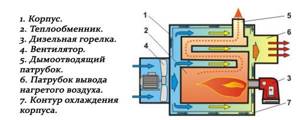
Photo 1. Diagram of the diesel heat generator. The main parts, the movement of cold and warm air are indicated.
Gas
This type is designed to constantly supply hot air to the premises. Gas generators are installed vertically . The heat exchanger receives the maximum part of the heat from the combustion products, thereby reducing the volatility of the smoke. That is why heat generators of this type require the installation of a fan, which improves exhaust. The efficiency of gas units reaches 90% .
Important! When purchasing gas heat generator models, it is worth considering its ability to operate at low gas pressure.
Universal
This type of generator is similar to diesel units. , vegetable fats can be used as fuel . The power of a diesel generator is much higher compared to equipment running on oils and vegetable fats.
Vortex
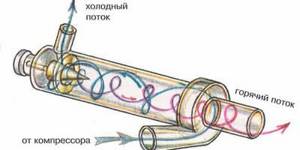
Differs in complexity of design . The operating principle is based on the vortex effect, in which a gas or liquid splits into two parts and forms a vortex.
With this process, an active increase in temperature in the combustion chamber is observed.
What is "air heating"?
In Russia, this term is usually used to refer to ducted air treatment systems. The air is heated (by various devices using gas, electricity, water, etc.) and distributed throughout the premises of the house through the forward (supply) and reverse (return) air ducts. The equipment is selected based on the feasibility of the fuel used (the most economical type is gas air heaters or gas heat generators), the power of the equipment is calculated on the basis of an engineering calculation that takes into account the heat losses of the premises for heating a particular house and the total heated area.
Kinds
The main task of a cavitation heat generator is the formation of gas inclusions, and the quality of heating will depend on their quantity and intensity. In modern industry, there are several types of such heat generators, differing in the principle of producing bubbles in the liquid. The most common are three types:
- Rotary heat generators - the working element rotates due to an electric drive and produces fluid turbulence;
- Tubular - change pressure due to a system of pipes through which water moves;
- Ultrasonic - the heterogeneity of the liquid in such heat generators is created due to low-frequency sound vibrations.
In addition to the above types, there is laser cavitation, but this method has not yet found industrial implementation. Now let's look at each type in more detail.
Rotary heat generator
It consists of an electric motor, the shaft of which is connected to a rotor mechanism designed to create turbulence in the liquid. A special feature of the rotor design is the sealed stator, in which heating occurs. The stator itself has a cylindrical cavity inside - a vortex chamber in which the rotor rotates. The rotor of a cavitation heat generator is a cylinder with a set of depressions on the surface; when the cylinder rotates inside the stator, these depressions create heterogeneity in the water and cause cavitation processes to occur.

Rice. 3: Rotary type generator design
The number of recesses and their geometric parameters are determined depending on the model of the vortex heat generator. For optimal heating parameters, the distance between the rotor and stator is about 1.5 mm. This design is not the only one of its kind; over the long history of modernizations and improvements, the rotor-type working element has undergone a lot of transformations.
One of the first effective models of cavitation converters was the Griggs generator, which used a disk rotor with blind holes on the surface. One of the modern analogues of disk cavitation heat generators is shown in Figure 4 below:
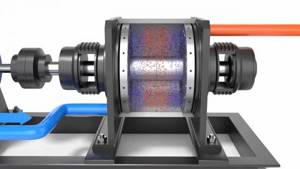
Rice. 4: disk heat generator
Despite the simplicity of the design, rotary-type units are quite complex to use, as they require precise calibration, reliable seals and adherence to geometric parameters during operation, which makes their operation difficult. Such cavitation heat generators are characterized by a fairly low service life - 2 - 4 years due to cavitation erosion of the housing and parts. In addition, they create a fairly large noise load during operation of the rotating element. The advantages of this model include high productivity - 25% higher than that of classic heaters.
Tubular
A static heat generator has no rotating elements. The heating process in them occurs due to the movement of water through pipes that taper in length or due to the installation of Laval nozzles. Water is supplied to the working element by a hydrodynamic pump, which creates a mechanical force of the fluid in a narrowing space, and when it passes into a wider cavity, cavitation vortices occur.
Unlike the previous model, tubular heating equipment does not make much noise and does not wear out as quickly. During installation and operation, you do not need to worry about precise balancing, and if the heating elements are destroyed, their replacement and repair will cost much less than rotary models. The disadvantages of tubular heat generators include significantly lower productivity and bulky dimensions.
Ultrasonic
This type of device has a resonator chamber tuned to a certain frequency of sound vibrations. A quartz plate is installed at its input, which produces oscillations when electrical signals are supplied. The vibration of the plate creates a wave effect inside the liquid, which reaches the walls of the resonator chamber and is reflected. During the return movement, the waves encounter direct vibrations and create hydrodynamic cavitation.
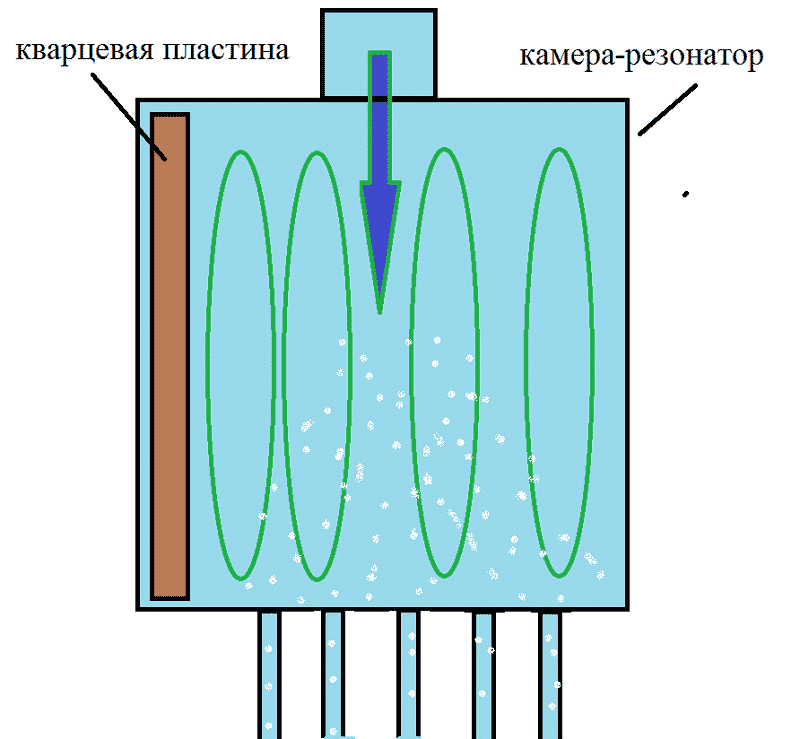
Rice. 5: Operating principle of ultrasonic heat generator
Next, the bubbles are carried away by the water flow through the narrow inlet pipes of the thermal installation. When moving into a wide area, the bubbles collapse, releasing thermal energy. Ultrasonic cavitation generators also have good performance characteristics, since they do not have rotating elements.
How to make this device yourself?
Making a heat exchanger for a chimney with your own hands is quite simple. To do this, use the following materials:
- metal sheet measuring 0.35 m x 0.35 m - 2 pcs.;
- pipe with a diameter of 0.032 m and a length of 2.4 m - 1 pc.;
- pipe with a diameter of 0.058 m and a length of 0.3 m - 1 pc.;
- cylindrical metal container with a volume of 20 l – 1 pc.
Step-by-step instructions for making a heat exchanger:
- Cut two circles with a radius of 0.15 m from sheets of metal. They will act as plugs.
- On a sheet of metal, mark the locations for placing the pipes. The largest circle with a diameter of 58 mm should be in the center, and along the contour there should be eight small circles with a diameter of 32 mm.
- A pipe with a diameter of 5.8 cm must be cut into eight equal parts using a grinder.
- Weld a plug to one end of the largest size pipe.
- Weld each pipe with a diameter of 3.2 cm to a metal circle one by one.
- Place another plug on the opposite side of the pipes, then weld it.
- Using a grinder, cut off the bottom of the metal container.
- On the side surface of the metal casing, cut two holes on opposite sides. Their diameter must correspond to the parameters of the chimney.
- Weld pipes to the prepared holes, with which the unit will be connected to the chimney.
- Insert the prepared core into the casing with pipes. Carefully secure the structure using welding.
- Connect the heat exchanger to the chimney.
- Treat the finished unit with heat-resistant paint.
How it works on coal, wood, coke
various types of solid fuel as fuel : coal, wood, coke. Many consumers use special waste obtained after processing plants. The most important factor for good heating of the device is the heat transfer of solid fuel, so most buyers use fuel with the highest efficiency.
Most solid fuel generators are capable of delivering an efficiency of 90% . The devices generate heat for 5-8 hours , and one addition of solid fuel is enough.
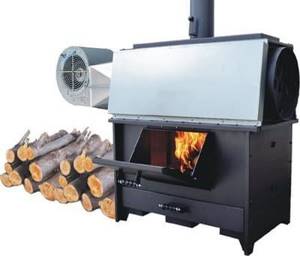
The most common boilers are those made of cast iron or steel . Cast iron heat generators are more popular, since this metal is capable of generating heat for a long time.
However, this material is quite fragile, since cast iron is subject to overheating , and as a result, cracks form on the boilers.
Steel boilers are less susceptible to temperature changes, but have a number of other disadvantages.
When working with these heat generators, it is necessary to constantly load fuel into the combustion chamber. Solid fuel equipment requires special and constant attention from humans, but at the same time, their convenience lies in the availability of solid fuel.
Air heat exchanger for ventilation
Plate air heat exchanger
The most common type is a plate air heat exchanger, which is a set of metal plates with high thermal conductivity, assembled in a stack with small gaps through which fresh and outgoing air streams are passed in independent streams. Inside the device, the flows are separated alternately, which allows for effective equalization of the temperatures of the supply and exhaust air.
The high thermal conductivity of metal plates makes it possible to intensively remove heat from the exhaust stream and actively heat the supply stream. Since the distances between the plates are very small, air filters are installed on both channels to clean the air from suspended matter, dust, and various particles that can fill the gaps and disrupt the operation of the heat exchanger. The resulting condensate flows into the pan and is then removed through a special channel. Air purification, no matter how thorough it may be, is not sufficient; it requires periodic washing of the heat exchanger plates and cleaning them of fatty deposits that accumulate in between over a certain period of time.
Rotary recuperator
The second, no less common type of heat exchanger is a rotary recuperator. It is a drive rotor made of corrugated metal (most often aluminum) plates assembled in the form of very closely spaced concentric cylinders. The rotor rotates using an electric motor with a chain drive. The supply and exhaust flows are supplied simultaneously to different sections of the rotor so that they pass through the gaps between the corrugated plates.
The principle of operation is to heat the plates when passing through the exhaust air zone and cooling with energy transfer when passing through the supply flow sector. In this case, partial mixing of the exhaust and supply streams occurs.
Both types of heat exchangers cope well with their functions and are widely used in ventilation systems of residential or industrial buildings. However, there are other types of devices that deserve special mention.
Advantages of a gas heat generator
A gas heat generator has a number of significant advantages that distinguish it from others:
- heating of the coolant occurs as a result of combustion of the most accessible type of fuel;
- The coolant in this system is air - this makes it the most economical and safe;
- air heating equipment works as quickly as possible - even a fairly large room can be heated in a short time;
- all systems of the gas heat generator are automated - this greatly simplifies the management and control of the system;
- if you set the air heating level to a minimum level, this will significantly save fuel consumption;
- Using a gas heat generator, you can not only heat your home - the system is also perfect for ventilating the room;
- minimal possibility of system breakdown, since it does not contain elements such as water (causes corrosion, contributes to pipe breaks, freezes) and pipes, but there are air vents in the heating system;
- there is no need to lay a large number of pipes and install radiators - this also significantly reduces the cost of the system and the costs required for its installation.
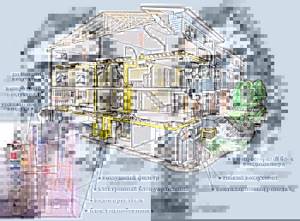
From all this we can draw a simple conclusion - today the gas air heating system is the most efficient and economical of all. When choosing an air heater, it should be taken into account that its power should be 20% higher than the power of the burner used.
The use of this type of heaters contributes to a significant reduction in fuel (gas) and electricity costs. In addition, such an air heating unit is capable of operating under any conditions.
Features of industrial heating
- Firstly, most often we are talking about work on energy-intensive Objects of a fairly large area, and there is a requirement for heating systems (as well as for all other auxiliary) systems to achieve the maximum possible energy savings. It is this factor that is put at the forefront
- In addition, often in heated rooms there are non-standard conditions in terms of temperature, humidity, and dust. Therefore, the thermal equipment and materials used must be resistant to such adverse effects.
- A number of Facilities may use flammable and explosive substances, and, based on this, the installed system must meet strict explosion and fire safety requirements
- Another important difference between the systems under consideration is, as a rule, their large total power. It can reach hundreds of megawatts. Therefore, boilers used to heat homes are often not suitable for the scale considered. The use of cascades from domestic boilers is simply becoming economically infeasible
- In addition, heating of industrial buildings is often designed and installed in a single complex with climate control systems. This makes it possible to heat industrial premises with large areas and at the same time save resources and the space occupied by highways. First of all, this method is used when organizing air heating
- The next feature that industrial heating of a building has is its “unconventionality”. There are certain standard solutions on the basis of which heating of a country house is carried out. These solutions can be applied with minor nuances almost everywhere and always. Technical solutions for large-scale Objects are much more diverse. The art of engineering in this segment lies in selecting the optimal technical solution. Before the start of the design stage, the most important step will be the competent preparation of the Technical Specifications. And when heating installations for industrial facilities take place, the Technical Specifications drawn up by qualified designers and engineers will help optimize the installation process. Designers carry out various engineering calculations. Based on an individually selected engineering solution, the most effective method of heating the Object in question is determined
- Often, when it comes to production, technological equipment is located at the Facility - machines, conveyors, production lines. Also, perhaps, the people working on it. This needs to be taken into account
- As a rule, uniform distribution of heat is necessary unless the project involves the creation of zones with a special temperature regime. By the way, the presence of such zones is also a feature that must be taken into account when organizing heating of industrial buildings
- As already mentioned, the traditional method for heating housing (in particular, cottages) using a household boiler and radiators is, as a rule, ineffective under the conditions under consideration. For this reason, industrial heating systems are built according to different principles. Recently, these are most often autonomous systems of the scale of the Object, and sometimes of its individual parts. Autonomous heating is easier to control than centralized heating (through CHP) due to the ability to control and regulate the consumption of fuel resources
- There are also some peculiarities at the operational stage. In the residential sector, the level of service of the heating system is often not professional enough. If heating is installed in a building for industrial purposes, then, as a rule, you can be sure that technical service will be carried out by a qualified team (most often, this is the service of the chief power engineer or a staff department of the enterprise with similar functions). On the one hand, this somewhat eases the responsibility of the installation organization. Most likely, after the facility is put into operation, no one will deal with “little things.” On the other hand, the requirements for the composition and level of writing of executive documentation are increasing. Operations service employees, being professionals, know well what exactly it should include and how to compile it. All necessary licenses, certificates, permits, equipment passports, and work completion certificates must be provided. Only after this the system will be put into operation
How to choose a heat generator?
When choosing heating equipment, you need to take into account a lot of details. First of all, it is important to assess the area of the heated room. The larger the building, the more powerful the heat generator should be.
The heat capacity of a building is calculated using the formula:
р=V·ΔT·k/860
p is the desired heat capacity;
V - heated area (the height, length and width of the room are multiplied);
ΔT is the difference in temperature in the building and outside it;
K - thermal insulation (indicators of the material with which the building is insulated).
Indicators of the most commonly used materials:
- double layer of brick - 1-1.9 W/m°C;
- single layer of brick - 2-2.9 W/m°C;
- wooden panels or corrugated sheets - 3-4 W/m°C;
- modern heat and waterproofing - 0.6-0.9 W/m°C.
The indicator for the number of kilocalories in kilowatts is 860. Generally accepted standards - for 1 kW of heat generator power, 30 cubic meters of forced air are required.

The power of the air heater must exceed the power of the burner by at least 15%. Such equipment is reliable and effective in any situation. Its use reduces energy costs
Knowing the value of heat capacity, you can select equipment that can heat the entire area of the room.
Nuances when choosing a heat generator
Before purchasing heating equipment, you must:
- arrange a chimney to release toxic gases;
- think over a system of ventilation ducts for circulating heated air;
- Using the formula, calculate the power of the device.
Having completed all these steps, you can safely go shopping.
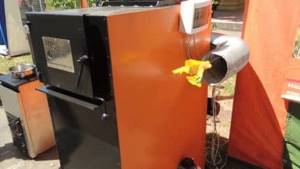
If there are problems with ventilation in the room, it is recommended to install a powerful floor-standing generator and synchronize its operation with ventilation that takes air directly from the street
To select a high-quality gas heat generator model, you need to pay attention to the following nuances:
- type and design of the burner - relevant if a fuel change may be required;
- warranty card and technical passport - a guarantee of the purchase of original (not defective) equipment;
- high-quality components - such equipment is more expensive, but its service life is much longer.
Taking these factors into account, the selected heat generator will last for many years.
Tips for choosing reliable equipment
By following simple recommendations you can avoid purchasing low-quality goods:
- It is better to make purchases at certified points of sale. Often, at wholesale stores and on the Internet, defective products are sold under the guise of high-quality equipment. The trap is the price halved.
- If it is not possible or you did not have time to calculate the required power of the device, then the consultants in the store will do this for you. To do this, you only need to know the area of the house, the height of the ceilings and the thickness of the walls. After making calculations, specialists will offer the optimal model for your home.
- It is recommended to purchase brands that have positive reviews on the Internet. You can also find out in advance how the equipment behaves during operation and other features.
For home use, the ideal option would be models such as Airmax D 28, Titan 25 (30, 35), Fuela, TG-7.5, Dragon 12.
Inverter generator for gas boiler
Currently, this type of generator for a gas boiler is the most modern. Its key feature is the presence of an inverter, which is responsible for the exact sinusoidal voltage.
With such a unit, high-quality electrical energy is generated in the shortest possible time, and you also get a high-precision sine wave, which is especially important for boilers with a sensitive automatic system.
The price of inverter-type generators is high, but the large number of advantages that such devices have completely justify it.
Advantages:
- Compact size and light weight, due to which the devices are very convenient to use, you can easily move them from one place to another, due to this the scope of use of such devices has been significantly expanded.
- During operation, the devices are practically silent; all extraneous sounds are eliminated by special silencers included in the design of the units.
- High efficiency and energy efficiency. One of the most important design features of inverter generators is the presence of a special module that is responsible for controlling engine speed. This is the reason for the high efficiency of the devices.
- Stable voltage in the network. Due to the fact that the device includes a voltage stabilizer, the device outputs electricity with almost ideal characteristics (voltage 220 V with a frequency of 50 hertz). That is why manufacturers of expensive gas boilers recommend using this type of device with their equipment.
- Long service life: such models are characterized by reliability and are designed for long-term operation.
- The output will be a pure sine wave.
An inverter generator for a heating boiler is a compact power plant, thanks to which the equipment will operate in standard mode, despite problems in the supply of electrical energy.
Requirements for installation
To connect a gas heat generator for air heating at home, you need to carry out preparatory work and purchase:
- flexible air duct, which is a galvanized tube for circulating heated air;
- tees are needed to create an air line and connect pipes;
- for taking in cold air and supplying hot air - a grille;
- to seal the line connections - aluminum tape;
- mounting fasteners;
- knife.
You should first take care of the air duct.

You can install a gas heat generator with your own hands, but it must be connected to the gas pipeline by representatives of the gas service, with which an agreement has been concluded for the supply of blue fuel and maintenance of equipment
The ideal option is to design airways - channels at the construction stage of the building.
To install heating in a finished house, you need to erect false walls and suspended ceilings. Pipes will be disguised in the resulting niches.
How to connect a gas boiler to a gas generator
Before connecting a gasoline generator to the boiler, you should carefully read the technical documentation of both devices and strictly follow it. It is imperative to ground both the generator and the heating unit. This is necessary, first of all, to ensure electrical safety, and also to ensure that a pronounced “zero” is formed in the generator. Without this, the boiler flame recognition system will not be able to function.
For normal operation of the unit, the output current sinusoid must be equal to 50 Hz. If this condition is not met, you simply will not be able to start the boiler. A voltage stabilizer or a high-quality inverter generator can solve this problem.
A very important point when commissioning a gasoline generator is the removal of exhaust gases from the premises. To do this, it is necessary to equip a chimney or ventilation system.
If the gas boiler does not work from the generator, then possible reasons may be:
- lack of grounding of the boiler and generator;
- incorrect connection of phase and zero;
- the need to use a voltage stabilizer.
DIY CTG
The simplest option for implementation at home is a tubular-type cavitation generator with one or more nozzles for heating water. Therefore, let’s look at an example of manufacturing just such a device; for this you will need:
- Pump – for heating, be sure to choose a heat pump that is not afraid of constant exposure to high temperatures. It should provide a working outlet pressure of 4 - 12 atm.
- 2 pressure gauges and sleeves for their installation - placed on both sides of the nozzle to measure the pressure at the inlet and outlet of the cavitation element.
- Thermometer for measuring the amount of heating of the coolant in the system.
- Valve for removing excess air from a cavitation heat generator. Installed at the highest point of the system.
- Nozzle - must have a bore diameter of 9 to 16 mm; making it smaller is not recommended, since cavitation can already occur in the pump, which will significantly reduce its service life. The shape of the nozzle can be cylindrical, conical or oval; from a practical point of view, any one will suit you.
- Pipes and connecting elements (heating radiators in their absence) are selected in accordance with the task at hand, but the simplest option is plastic pipes for soldering.
- Automatic switching on/off of the cavitation heat generator - as a rule, it is tied to the temperature regime, set to switch off at approximately 80ºC and switch on when it drops below 60ºC. But you can choose the operating mode of the cavitation heat generator yourself.
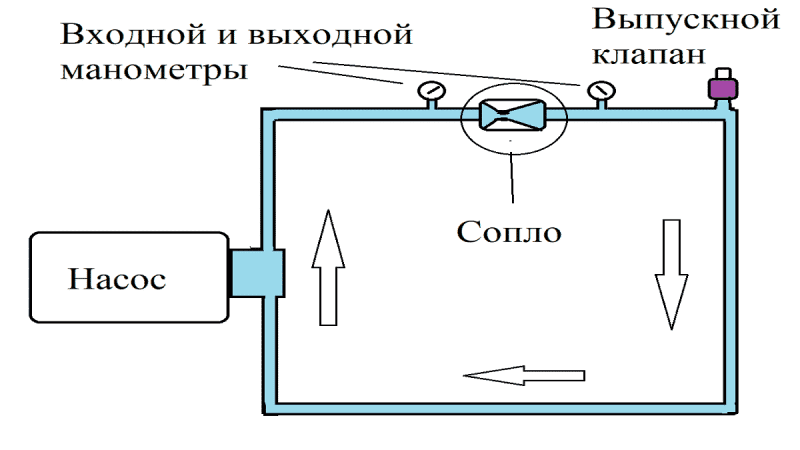
6: diagram of a cavitation heat generator Before connecting all the elements, it is advisable to draw a diagram of their location on paper, walls or on the floor. The locations must be placed away from flammable elements or the latter must be removed at a safe distance from the heating system.
Assemble all the elements as shown in the diagram and check for leaks without turning on the generator. Then try the cavitation heat generator in operating mode; the normal increase in liquid temperature is considered to be 3-5ºC in one minute.
Flushing the heat exchanger
Timely washing and cleaning of such devices allows such devices to serve for many years without failure. Heat exchangers that use heated gases from burning solid fuels as a coolant are especially in need of timely cleaning.
As a rule, in such systems, the plate channels become clogged with soot, which sharply reduces the efficiency of such a device, and if the working holes are excessively clogged with combustion products, the device can completely fail.
For high-quality cleaning of such heat exchangers, the device is completely dismantled and the channels are thoroughly cleaned of soot, followed by washing the plates.
The circuit in which high-hardness water circulates must be washed with a special descaling agent or citric acid solution. If there is a significant layer of lime deposits, the plates are cleaned mechanically. For this purpose, the collector is cut along the seam with a grinder. The plates are cleaned of scale, then the collector is welded in its original place.
The “pipe-in-pipe” heat exchange system is cleaned in a similar way. If it is not possible to effectively remove scale by chemical means, the pipe is cut and the scale is removed mechanically. Then the device is assembled.
Price
You don’t have to make a heat generator yourself. There are ready-made devices available for sale. Finally, I will give the cost of some popular models:
| Model | Price in rubles |
| VTG 5.5 kW | 76400 |
| NTG-11 10.1 kW | 115000 |
| EUROMIX REV 100, 100 kW | 472000 |
| Euronord H 50 for premises up to 7500 m2 | 240 000 |
That's all the information about what a heat generator is.
